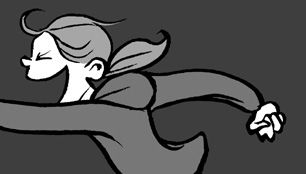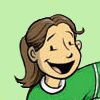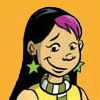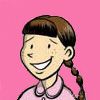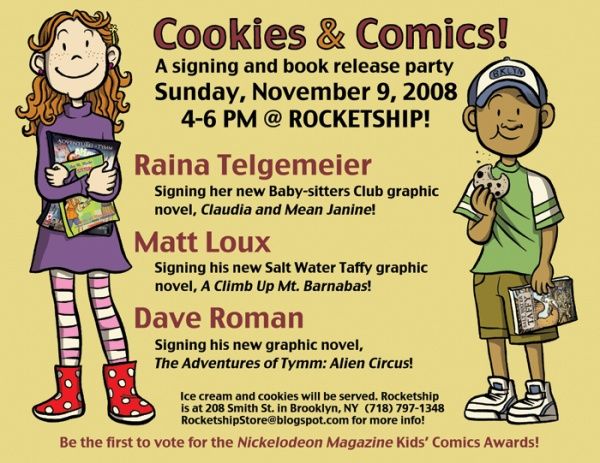Raina Telgemeier is a superstar. Just ask any of the kids that shop at ROCKETSHIP. All summer long, one of the most frequently asked questions was "Do you have the new BABY-SITTERS CLUB yet?" Forget SECRET INVASION; Raina's latest book was the most anticipated book of the season. Between adapting (and bringing a new generation of readers to) that beloved series, she also draws a terrific webcomic called SMILE, which will soon be published by Scholastic. She and her husband (cartoonist Dave Roman) are a fixture at most conventions with their "Comics Bakery" booth, and her lighthearted brushwork and smooth storytelling skills have made Raina a popular attraction for children and adults alike. While preparing for an upcoming BABY-SITTERS CLUB Volume 4 Release Party, she took the time to answer a few questions....
Alex: You've spent the last few years immersed in the world of THE BABY-SITTERS CLUB. Can you talk about the process of translating prose novels into comics? Did you find that the visual cues you needed were in the text?
Raina: The BABY-SITTERS CLUB books made it easy. They're written in a very straightforward style, describing what the characters are doing, what they are wearing, how they fix their hair, what they eat.
A: Did the pacing or structure change at all from prose to comics?
R: I tried to stick with the pacing and the structure that already existed in the books, for the most part...although by the fourth graphic novel, I was taking quite a few liberties. Re-arranging the chapters, working in scenes from other volumes in the series, re-writing dialogue. Since I was only drawing four books from a sprawling, 131-book series, I decided to condense some of the ongoing plotlines a bit. The graphic novel series ended up having its own chronology, slightly different from the original series, so you don't need to have read the original books to appreciate the comic versions
A: Have you heard from any kids that have read your BSC graphic novels, that then tracked down the original novels?
R: A few. It's actually more common to hear from kids who have read some of the prose books, and started reading the graphic novels afterward. The original books are sadly out of print now, so kids usually find them in libraries, or someone they know gives them an old box of books. Since there are so many books in the series, chances are they don't have a complete set, and have read the books in random order. Which still works okay, as each book has a self-contained story.
A: In terms of designing the characters (who are well known by the legions of people who have read the BSC novels), did you find it difficult matching the characters on the page with the characters people see in their minds?
R: The main characters are all very archetypal. One is sporty, one is nerdy, one is trendy, and so on. Designing the characters was easy. Having longtime BSC fans embrace my style of drawing, though...not quite as easy.
A: What was the feedback like?
R: Like most YA novels from the 1980s, the covers of the original books were realistic paintings of realistic-looking kids. So, I think there were people who heard "Baby-sitters Club graphic novels" and expected them to be full-length, realistically-painted (or drawn) books. And what they got was my super-cartoony style. For the readers who are also fans of comics or cartoons, this was easy to swallow, and most of them loved the adaptations. But some of them claimed to "hate" cartoons, and they hated that I was "ruining" their favorite characters by turning them into cartoons, I guess because they felt it undermined the stories somehow. I got actual hate-mail about this! I don't see how anyone could NOT love cartoons!
So, I think it really depends what you're into. Everyone has different tastes. I can confirm that it works with kids, though. Kids dig the art and they dig the stories. I'm not surprised, since I liked the stories so much myself, when I was a kid.
A: I can confirm that as well. The response from kids in the shop has been phenomenal.
Now that you've adapted four novels to comics, do you find yourself reading any books and automatically thinking of how they would look as a comic?
R: Yeah, pretty much EVERYTHING I read now! Really, though, I tend to focus on characters and their body language first. So I can read a book that seems very visual and might make a cool world-building comic; for example I just read City of Ember, which is dark and moody and has a lot of interesting set pieces. For some artists, that might be the main draw of adapting a book like that. But the thing I could see most clearly in my mind while reading it were the characters' movements, the way they run or skip or react to an event, the way their faces look when they talk. That is the part that interests me most. I really like to act through my drawing. The film adaptation of that book just came out, and I haven't seen it yet, but I'm sure the characters will be played differently than I imagine them.
A: What was the origin of SMILE? Did you initially see it taking on the life of its own that it has?
R: It had always been my intention to create a comic about my teeth, mostly because I found myself telling people about what happened to them over and over again. (For those who don't know, I knocked out my two front permanents in a trip-and-fall incident when I was a kid.)
I had no idea how long the story was going to be, though, and what kinds of extra plot elements I would explore. But I had so many anecdotes about my awkward teen years, that fit into the time period of my tooth story, and it made sense to work them into SMILE. As the strip hit the web week after week, I found my readers really responding to the relationships and character interactions. I let things unfold organically, writing the comic in 10-to-20-page increments, and taking breaks whenever my BSC schedule ramped up. I've been working on SMILE as long as I've been working on the BSC comics-for the past four years. It's cool to be able to focus on SMILE full-time now! (It's going to be published as a complete graphic novel by Scholastic in early 2010.)
The thing about SMILE that has surprised me the most, is how many people can relate to it in one way or another. Everyone has a dental horror story of some sort. Going through those experience as a kid, I felt really isolated and weird. But drawing the story has connected me with hundreds and hundreds of kindred spirits.
A: Has SMILE entailed any grisly research into the details of dentistry?
R: I have written and drawn most of it from memory, actually-but now that it's being prepared for print, I'm having a dentist consult the manuscript for accuracy. I look up reference periodically, like pictures of dental chairs and nitrous masks, and I also read up on each kind of dentistry as I go along-there are a lot of different kinds! Sometimes I'll look up something that I think is going to be simple and factual, and there will be a giant picture of a disgusting impacted tooth or whatever, and it'll make my skin crawl. I try to keep the grossest, grisliest elements of dentistry OUT of the comic-but some of it can't be avoided!
A: You've developed a very distinct style. In terms of pure craft, who were your influences?
R: I grew up reading comic strips and watching anything that was animated. My favorite newspaper strips were Calvin and Hobbes, For Better or For Worse, Foxtrot, and Nancy. And I was a real Disney kid, watching and re-watching the movies, the classic cartoons, and the cheesy shows they put on the air in the 80s and 90s. Aside from Disney, if it was a cartoon and it was on TV, I was probably watching it. I was obsessed with the Smurfs, the Get-Along Gang, and Tiny Toon Adventures, and the early seasons of the Simpsons. All of those early influences informed my drawing style.
A: It seems like your illustration style would lend itself to animation; is that something you've ever played with or looked into?
R: People tell me that a lot! I used to make flip-books in elementary school; I brought them in for show and tell, and I recall my classmates being less than impressed. Maybe it's because they were drawn in pencil and you can't see that very well from the back of a classroom? Who knows. But I started to realize that animation was a very collaborative effort, and you need certain tools, and you need to draw thousands of pictures just to make something move, and you probably need a team of people to make it happen...with comics, you just need a pen and paper. I really like working alone, and making things myself. And I really just love sequential art, so making comics suits me perfectly.
A: Who are your more general influences? Not drawing-wise, but in terms of storytelling, mood...
R: I read the Barefoot Gen series when I was very young, which broke my heart, but tipped me off to the concept of comics-as-serious-storytelling-tool. Later on, I got into Lynda Barry and Adrian Tomine... the two of them had a huge influence in leading me to the kinds of stories I wanted to tell: slice-of-life stories, some without neatly tied-up endings. Short mood pieces. Realistic fiction.
There are so many other things I've taken influence from over the years; it's an ongoing process.
A: What are your preferred tools?
R: I lay everything out with a light blue colored pencil, which lets me figure out my compositions and be really messy. Then, I go over that with an F graphite pencil. My pencils are very tight and precise. I ink with a Windsor & Newton no.2 sable brush and waterproof India ink, and I use Pitt pens for straight lines, letters, eyeballs, small details, and so on.
A: Are these something you use out of habit, or do you switch up based on the project?
R: I use the same tools no matter what I'm working on. The only thing I ever change up is paper size. BSC pages were done on 11 x 14" Bristol board, which I have found is my ideal working size-not so big it takes forever to ink a page, but not so small that I will give myself hand cramps from drawing tiny backgrounds. SMILE pages are smaller-they're drawn on 9 x 12" Bristol. I decided to scale my SMILE pages down because they were to be drawn for the web, and I needed to be able to draw and ink them rather quickly and then fit them on my little scanner. Those pages go really fast, but they're also simpler as a result. I have a bigger scanner now, but I'm sticking to finishing SMILE in the smaller format, just so the whole thing is consistent. I'll probably go back to working at the larger size for my next project.
A: Do you have a typical workday?
R: I don't really have a typical workday, no. My schedule changes based on what stage of a project I am working on. When I'm in the thick of things, I generally get up between 9 and 10, read and write email while I eat breakfast, then get down to writing or drawing or inking or whatever I'm doing on that particular day. I take frequent breaks, for lunch, running errands, or getting a little exercise in, but I usually work until 7 or 8. I'll eat dinner and watch a bit of TV most nights, and then it's back to work! Depending on how close to a deadline I am, I'll work till about 11 PM, or if I'm really crunching, till 1 or 2 in the morning. I find that the later I work, the harder it is to fall asleep afterward.
Time of year also seems to play a role in what I do during the day, because during the summer months, we travel and do so many conventions, I'm very often either on the road, or preparing to be on the road. That means making mini-comics, creating original artwork to sell, doing the accounting for our shows, figuring out how to get places because we don't have a car...that kind of stuff takes way more time and mental energy than I ever expect it will. I guess I'm lucky to work from home, because otherwise I'd have to sneak that stuff in during lunch hours!
Raina and Dave Roman at the MoCCA Art Festival.
A: Aside from the SMILE graphic novel, what other projects do you have on the horizon?
R: My husband, Dave Roman, and I are scripting two X-men shoujo manga graphic novels. They're being drawn by an Indonesian artist, Anzu, and the first book comes out in April.
I've got a couple other irons in the fire, but nothing I can really talk about yet.
A: What is your dream project?
R: I don't have a specific dream project... but I do want to keep making comics for my current audience!
A: Thanks, Raina!
R: Sure!
Be sure to keep an eye on the ROCKETSHIP store site for more info about the BABYSITTERS CLUB vol. 4 release party!

